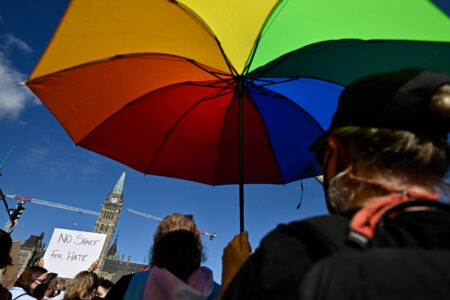
Roughly fifteen years ago, the Supreme Court of Canada distributed a memorandum to law schools across Canada, in which it advised academics not to send new publications directly to the judges on the Court. It did so ostensibly on the basis that it was unfair to expect litigants to respond to materials and ideas they had never seen. Any practitioners who saw the memo might have taken it to imply that the Court would only draw upon those scholarly works specifically cited by the parties. Recent developments show that this would be a major misunderstanding. Practitioners at the highest appellate level in Canada may need to be more attentive to academic scholarship and debates.
Several recent cases have seen the Court relying upon material not directly cited by parties or interveners, and we hope to write more on this topic soon. For now, though, we want to hone in on one particularly intriguing paragraph from the recent majority decision in Loyola. At para. 60, Justice Abella writes:
Religious freedom under the Charter must therefore account for the socially embedded nature of religious belief, and the deep linkages between this belief and its manifestation through communal institutions and traditions: Victor Muà±iz-Fraticelli and Lawrence David, ”œWhence a nexus with religion? Religious institutionalism in a Canadian context”, forthcoming, at p. 2; Dieter Grimm, ”œConflicts Between General Laws and Religious Norms” (2009), 30 Cardozo L. Rev. 2369, at p. 2373. To fail to recognize this dimension of religious belief would be to ”œeffectively denigrate those religions in which more emphasis is placed on communal worship or other communal religious activities”: Dwight Newman, Community and Collective Rights: A Theoretical Framework for Rights held by Groups (2011), at p. 78. See also Will Kymlicka, Multicultural Citizenship: A Liberal Theory of Minority Rights (1995), at p. 105.
The passage is highly significant. As the majority proceeds to say in the next paragraph, Loyola’s claim rested on the ”œcollective aspects of religious freedom”. What distinguished its claim from the argument rejected in S.L. v Commission scolaire des Chenes, [2012] 1 SCR 235, was the fact that Loyola was created to advance a collective interest in teaching children in a manner that advanced, and was consistent with, the Catholic faith. To hold that Loyola was required to teach Catholicism from a standpoint of professional neutrality would be to effectively undermine the very point of having a Catholic high school in the first place.
So the idea that religious freedom has (at least sometimes) a collective dimension was an important pillar in the majority’s reasoning. In support of that premise, the majority cited four academic works. None were referenced in any of the factums submitted by the parties or interveners. The Registrar of the Supreme Court of Canada has confirmed to us, moreover, that no supplementary books of authorities were submitted. In other words, the lawyers involved in the case had no specific notice that the Court would engage with these particular works. Indeed, some are not even in the Supreme Court of Canada’s library collection. To know what thinkers, ideas, and arguments might catch the attention of the Court, lawyers would have needed to have some appreciation of the works relied upon in earlier cases, as well as the debates swirling through legal academia.
Will Kymlicka is, of course, one of the world’s leading philosophers on multiculturalism and collective rights. Multicultural Citizenship has been cited by the Supreme Court on two earlier occasions: in R v Kapp, 2008 SCC 41 and Lavoie v Canada, 2002 SCC 23. Neither case draws upon the particular page cited in Loyola. It is, however, clear that the work is well-known to the Court. Likewise, Dieter Grimm’s work has been cited by the Court on earlier occasions. Most importantly, the Court in S.L. cited ”œConflicts Between General Laws and Religious Norms” (2009), 30 Cardozo L. Rev. 2369. It would be natural for the Court to draw upon it again – though, in S.L., the Court cited it for the proposition that ”œReligious neutrality is now seen by many Western states as a legitimate means of creating a free space in which citizens of various beliefs can exercise their individual rights” [emphasis added].
Dwight Newman has also been cited on several occasions, but chiefly for his more doctrinal work on the duty to consult. Community and Collective Rights, which is more theoretically oriented, had not previously been cited by this or any Court. How did it come to the attention of the Supreme Court?
It is possible that the book was invoked indirectly – i.e., that one of the parties or interveners referred to an article, book, or case that relied, in turn, upon Community and Collective Rights. Counsel for one intervener had previously mentioned the book in conversation with Newman. But it is also possible that it reached the Court through an altogether different avenue. At a presentation last fall, Newman argued that some of the themes from the book could help to inform the Court’s approach to collective rights. A Supreme Court justice was present.
The most intriguing of the four citations is the first: Victor Muà±iz-Fraticelli and Lawrence David’s ”œWhence a nexus with religion? Religious institutionalism in a Canadian context”. To say that a paper is ”œforthcoming” is to suggest that it has not been published yet. But if it has not been published, then how did the Court obtain a copy? The Supreme Court of Canada Library has confirmed that it does not have one on file. The paper is not, so far as we can see, on SSRN or any other online database at the moment, and there is no indication that it was available online before the Court cited it. We have good reason to believe that the authors did not send the piece to the Court. It appears, rather, that the piece was simply in circulation amongst scholars, as academic papers often are, and somehow found its way to a judge or clerk.
The Court’s reference to such a work raises challenging questions. Inasmuch as the paper was unpublished and, so far as anyone can tell, not yet in press, it is possible (at least in principle) for the work to be changed after being cited by the Court. Now, to an important extent, this is highly unlikely. Muà±iz-Fraticelli has written extensively on pluralism. It would be quite a turnaround if he were suddenly to abandon his scholarly commitment to the idea of collective rights! There is, however, a risk that the paper could ultimately contain propositions that the Court would not be prepared to endorse. This example of a citation to a ”œforthcoming” work is an immensely intriguing example of the Court’s engagement with scholarly discourse, and one that raises additional questions.
What is clear is that the Court may well engage, at some level, with ideas not brought before it by counsel. Some may object to this seeming departure from the adversarial process. We are not so troubled. Rather, we see this as a natural by-product of the Court’s role as interpreter of the Constitution. In defining the scope and limits of constitutional rights, the Court will sometimes need to appeal – even if only implicitly – to highly abstract questions of legal, moral, and political philosophy. One would therefore expect them to be alert to the sort of theoretical conversations and debates we typically associate with academic life. (Indeed, it is no accident that many legal academics have clerked for appellate court judges: this work is often regarded as quasi-academic in nature.) In any case, it would almost certainly be damaging to constitutional interpretation and adjudication if judges were unable to reach beyond the submissions of lawyers – which may often rest on reasoning and arguments that are less theoretically rich than what the Court needs.
The bottom line: Lawyers appearing at the Supreme Court of Canada – at least, those who want to be ahead of the curve – need to realize that they are engaged in not just an adversarial practice but an academic one (in all the best senses) as well.
At the same time, this practice raises other issues to which we may return in future posts or papers. In particular, the Court’s readiness to draw on scholarly ideas circulating in the legal academy suggests that we should be concerned if it is dominated by only one or two points of view. To be sure, this may not be such a problem in the case of Loyola. There has been a healthy range of scholarly opinion expressed on collective rights. But it is, again, something we should keep an eye on. As the old line goes, ideas have consequences.
(This blog post was co-written with my colleague, Professor Dwight Newman, Canada Research Chair in Indigenous Rights in Constitutional and International Law at the University of Saskatchewan’s College of Law.)






